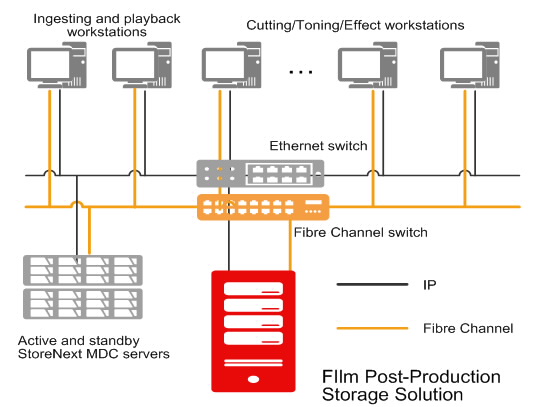Traditional IT Architecture Challenged by Increasing Video Bit Rate
The following table lists the bit rates corresponding to the mainstream film formats, including HD, 2K, and 4K.
| Film Format
|
Bit Rate (MB/s)
|
| HD film DPX 1920*1080@30fps, RGB4:4:4,10bit
|
249
|
| 2K-10bit RGB/full frame DPX
|
305
|
| 4K uncompressed 10-bit DPX
|
1210
|
Bandwidth requirement: HD, 2K, and 4K films require the production system to provide a stable bandwidth of 2.5 GB/s, 3 GB/s, and 12 GB/s respectively for processing 10 channels of data flow.
Latency requirement: The editing process does not tolerate frame loss or compromised image quality. Therefore, the maximum latency can not be greater than 100 ms.
If a storage system that meets the latency requirement can provide a higher stable bandwidth, it has more powerful concurrent data processing capability, supports more workstations, and requires less construction costs.
Difficult to Share Data
Film post-production includes cutting, toning, special effect, coding, transcoding, rendering, and compositing. These working procedures run on different operating systems such as Mac, Windows, Linux, and UNIX. The editing process requires film source data to be shared among heterogeneous platforms to improve film production efficiency.
Limited Space and High Energy Consumption
The increasing number of equipment makes it very challenging to cut energy consumption and minimize server footprints in overcrowded data centers.
Overview
Boasting superb performance, flexible scalability, and optimal energy efficiency, HUAWEI Film Post-Production Storage Solution resolves such problems as low performance, poor business continuity, lack of protection for critical data, and high energy consumption. It provides customers with high-performance and high-reliability storage service that reduces the total cost of ownership (TCO) and improves production efficiency.

Components
- HUAWEI OceanStor Unified Storage
- Quantum StorNext Shared File System

